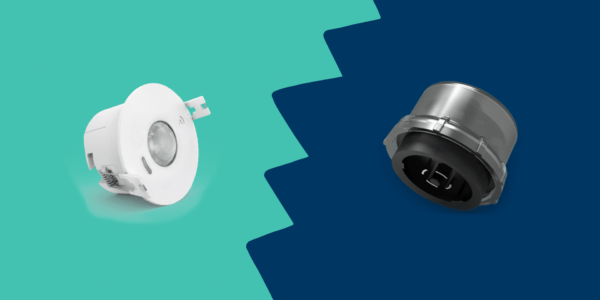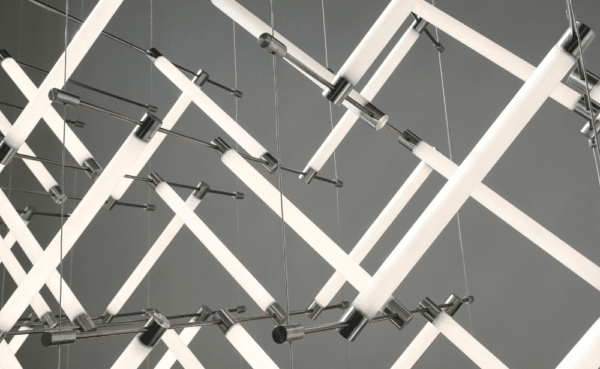We borrow the title of the 1811 novel by Jane Austen comparing ‘sense’ (practicality) with ‘sensibility’ (emotion).
In this post, we compare the ‘practicality’ of sensor types that have been around for decades with the innovative use of emerging sensor technology to control the buildings of today and beyond. Optimising the wellbeing of its occupants, and monitoring and surpassing energy-saving initiatives and goals!

Brief History
Although sensors have been in use for more than 40 years, initially they were used principally for exterior security lighting. However, the change to LEDs and increase in digital lighting and smart controls allows sensor technology to provide huge benefits to commercial lighting systems.
The most common sensor types included PIR, ultrasonic, microwave, and combinations of these, often called ‘dual technology’.
These types of sensors still form the bulk of today’s sensor sales, but each comes with its own benefits and drawbacks.
1. PIRs
These use infra-red sensors to detect heat, using differential detection by measuring multiple points and any change in infrared emissions between those points are used to indicate movement.
They are termed “passive” as they don’t emit any form of signal, but rather analyse the incoming infrared radiation from the environment. They are cheap to produce, reasonably energy efficient, and commonly integrated into lighting systems.
Their drawbacks include limitations in range and sensitivity, as well as being susceptible to environmental factors such as changes in temperature or physical obstructions. They tend to trigger for no apparent reason and regular maintenance is necessary as it can be dust webs, or a spider, triggering the light.
However, they are still the most common sensor on the market due to their cost-effectiveness and simplicity.
2. Microwave Sensors
The main advantage of a microwave sensor over a PIR is its ability to detect “through” objects. They use a form of radar, emitting continuous microwave signals through their environment. The returning signals either remain unchanged or, when bounced back from a moving object, change in frequency to indicate the presence of that moving object..
Microwave sensors for lighting are calibrated for presence detection but can also measure speed, proximity, and distance. They are not as susceptible to ambient temperature and pressure changes but can be triggered by non-living objects such as moving trees or leaves blowing in the wind. These sensors can also detect through thin walls and glass, making them ideal for cubicle-type situations like toilet blocks. However, this ability to detect through walls can sometimes lead to unintended triggers outside the intended zone.
Microwave sensors can be installed behind gib board or within furniture, providing the added benefits of enhanced security and aesthetics.
Additionally, as they don’t require a ‘line of sight’ for detection, they can work well for odd-shaped rooms or where obstacles would block a conventional PIR.
3. Ultrasonic Sensors
Tending to be more expensive, these have become popular for some applications.
They work on a similar principle to microwave sensors, relying on the doppler shift in reflected waves, but ultrasonic sensors emit a high frequency soundwave.
They are sensitive enough to detect minor movements, which can be useful in some situations where people may be present in an area but remaining very still.
The downside is the potential for false triggers from vibration or airflow, from temperature and pressure fluctuations, and limitations in their ability to work with higher ceiling heights.
Tomorrow’s Technology . . . Today!
The advantage of the massive ‘sensor explosion’ we are currently experiencing, is the rapid evolution of the employed technologies. Sensors are becoming more sensitive, more customisable, and offering much greater functionality.
At Intelligent Environments we know that what the end-client really wants is simplicity of use. They don’t want complicated control through a computer screen, or multiple pages on a lighting control panel. They want control to be ‘automatic’: responding, seemingly intuitively, to the needs of those using the space.
The utilisation of innovative sensor technology in the design of a control system, enables this to happen. The sensors we propose do so much more than simply turn lights on or dim them down. Combined with zencontrol software and the appropriate programming they can monitor and predict behaviours, creating more precise control for both user comfort, and energy saving.
Smart Sensors
zencontrol engineers its range of smart sensors to offer the best options for nearly every application. Microwave and PIR, wired or wireless, providing the flexibility to choose the best sensing technology for the application.
Options include an internal DALI-2 bus power supply allowing for direct connections to DALI drivers, switches and additional sensors, eliminating the need for an external PSU. Additionally, you can link the DALI-2 power supplies from multiple smart sensors to increase the available DALI-2 Bus current and connect even more DALI devices to a DALI-2 line.
The sensor can also support two switches. 230V switches can be wired into the smart sensor to enable lighting control capabilities. Connected switches can be used as part of a DALI-2 system, or standalone to control the connected lighting. This allows for features such as dimming, colour adjustment, scenes, and customised control.
Connecting a zencontrol 230V relay to the sensor allows you to control switched fixed loads or non-DALI lighting products while maintaining compliance with IEC62386-208 standards.
Multi Sensors
Our zencontrol multi sensors provide feedback not just on whether the area is occupied, and lights are on or off, but can also provide information (when required) on air quality, light colour/intensity, sound, pressure, and more.
The advanced technologies reporting on, IAQ, VOC, eCO2, humidity, motion, sound pressure, temperature, and light levels allow all you need to optimise your space. One single, integrated system to monitor air quality, control climate, optimise the utilisation of your space, and save energy! Everything you require to ensure a comfortable, safer and energy-efficient environment.
You can fine-tune building performance using the zencontrol multi-sensor and cloud platform. With real-time insight into ventilation performance, space utilisation, comfort levels, and more, you can make data-driven adjustments. These optimizations create a healthier environment that boosts well-being and productivity.
Thermal Technology
Thermal imaging provides the ability to track heat. The zencontrol thermal sensors we propose leverage cutting-edge technology. They allow precise human presence detection in any room, even when occupants remain still. A huge advantage is that these thermal sensors ensure accurate sensing without compromising privacy.
This sensor can configure up to 4 distinct sensor zones from a single device. This makes it ideal for applications like aged care. One sensor can monitor multiple areas, such as the bed, armchair, and remaining space. Lighting control and targeted alerts can be enabled. Precise, area-specific sensing, without complexity!
Thermal sensors can even have a role in people counting, accurately counting people entering and exiting an area. Not only does it track movement, but it also reports real-time occupancy levels for any room or zone. Data-driven insights to optimise your space, all from a single sensor.
Interface With Other Building Technologies
By adding a zencontrol application controller, zencontrol sensors can be integrated into your building’s existing infrastructure whilst maintaining the ability to stream sensor data to external control systems via BACnet or MQTT. Seamless connectivity for smarter building management.
Summary
Not sure what Ms. Austen would think of today’s technology race. Combining advancements in detection abilities and reliability is crucial. This, along with the challenges of improving health and well-being, contributes to our planet’s longevity. Together, these efforts bring practicality and sensibility into harmony. It seems that once again, “Sense” and “Sensibility” are intricately intertwined.
We provide free consultations New Zealand wide, reach out to us.


